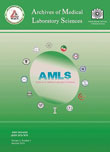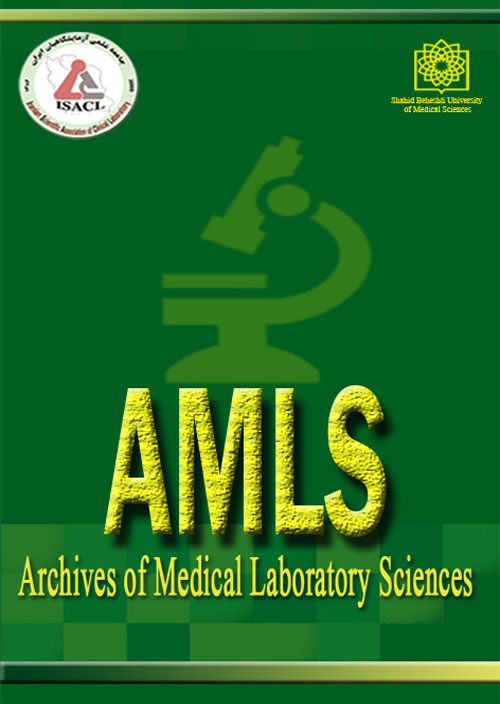فهرست مطالب

Archives of Medical Laboratory Sciences
Volume:2 Issue: 3, Summer 2016
- تاریخ انتشار: 1395/05/31
- تعداد عناوین: 6
-
-
Pages 79-83BackgroundActivated platelets shed microparticles (MPs) in vivo and certainly in vitro under storage. Like platelets, platelet-derived MPs contribute to hemostatic and inflammatory responses. We sought to determine the interactions between platelet MPs and peripheral B lymphocytes in the healthy blood circulation to propose a possible role for platelet MPs in the functioning of B cells.Materials And MethodsAn enzyme-linked immunosorbent assay (ELISA) was established to determine the normal interactions between human peripheral blood B lymphocytes and platelet MPs. B cells were isolated and bound to the wells of microtiter plates using coated anti-CD19. Then the presence of attached MPs was surveyed. Also, platelet MPs were separated from human platelet concentrates and applied to confirm the new binding capacities of B cells for these microvesicles.ResultsPlatelet MPs were recognized in the wells of ELISA in which only B cells were isolated. So MPs were bound with peripheral blood B cells. Furthermore, using this method, the role of CD40/ CD40L interaction was displayed for the binding.ConclusionIt seemed that the binding of platelet MPs to B cells normally took place in vivo and a percent of B cells circulate in blood in connection with platelet MPs.Keywords: ELISA, Platelet microparticles (Platelet MPs), B cells, CD40L
-
Pages 84-88BackgroundThe present article focuses on the design and development of a highly sensitive and convenient approach for rapid detection of animal species and cross contaminations quickly during cell cultures as most important document for manufacturing working cell bank system. This test is one of the four most important documents during implementing the banking system. By using this modified test, one of the major risks in cell culture laboratories, cross- contamination and misidentifications with microorganisms of cell lines will also be important to be confirmed.Materials And MethodsA PCR _RFLP assay was optimized based on the use of a pair of primers that anneal to a portion the cytochrome b gene in all the species. The amplification product was digested with a panel of six restriction enzymes and the pattern derived was resolved on 3% high resolution agarose gel for 2 species, human & primate. As a control test iso enzyme assay as a conventional method was used.ResultsThis protocol produced a unique restriction pattern and the origin was confirmed by this analysis. The sensitivity in detecting interspecies cross contamination was at least 100 pg DNA/reaction, which was sufficient for detection of each species of DNA.ConclusionThe method developed in this study will provide a useful tool for the authentication of animal species and is also more comparable and time consuming, compared with conventional analysis. Using this method, significant differences between human and non-human as well as cross- contamination between different cell lines are simply distinguished.Keywords: cell authentication cross contamination, PCR-RFLP assay, restriction enzyme
-
Page 89BackgroundThe major problem of DNA vaccine is less immunogenicity of them verses other killed or live whole organism vaccines therefore adjuvants for use in this kind vaccines is very necessary. Genetic adjuvants with bacterial sources are an appropriate approach to modulate immune responses to DNA vaccines. Listeria Monocytogenes proteins such as Listeriolysin O (LLO) with CD4 and CD8 epitopes can be as an adjuvant to initiate both innate and adaptive immune responses if the protein cytotoxicity can be eliminated. Herein we constructed a truncated LLO plasmid as genetic adjuvant and tested it in combination with a DNA construct as a model vaccine.Materials And MethodsAbout 1340bp of the 5' end of whole LLO gene was amplified by PCR on DNA purified from Listeria Monocytogenes. Sequential sub cloning of truncated LLO into the Xho I/EcoRV sites of pcDNA3.1 plasmid, downstream of CMV promoter was done. pLLO plasmid was transfected to HEK293T cell line by lipofection method. LLO protein expression from transiently transfected 293T cell lysates was confirmed by western blotting. Then the adjuvant activity of LLO in BALB/c mice model was analyzed using proliferation test.ResultsDouble digestion of pLLO plasmid with the enzymes that were applied for cloning led to the isolation of two fragments with expected sizes. The final plasmid was also confirmed following sequencing reactions. Moreover, expression of LLO was evidenced in transfected 293T cells, compared to non-transfected controls. In vivo study was shown, high significant proliferative responses in LLO co-immunization pattern.ConclusionIn DNA vaccine study, LLO co-administration plasmid could be a suitable genetic adjuvant to enhance cellular immune response of vaccine.Keywords: DNA vaccine, molecular adjuvant, Listeria Monocytogenes, listeriolysin O
-
Pages 94-101BackgroundInfluenza viruses are a significant cause of morbidity and mortality. The influenza virus pandemics, 1918, 1977, and especially the most recent one, A/H1N1/2009, made evident the need for generating recombinant Influenza H1N1 antigens which are essential to develop both basic and applied research programs. Among influenza virus proteins, haemagglutinin (HA) is a major surface antigen of influenza virus, thus it is highly topical in influenza research and vaccine engineering programs. Alternatively, expression of fragments of the HA (HA1 and HA2) proteins in prokaryotic systems can potentially be the most efficacious strategy for manufacture of large quantities of influenza vaccine in a short period of time.Materials And MethodsThe gene encoding the HA1 protein of the influenza A/Puerto Rico/8/34 was amplified by PCR, then cloned into pTZ57R/T cloning vector. The fidelity of the HA1 open reading frame was confirmed by bidirectional sequencing, then sub-cloned into pET28a prokaryotic expression plasmid, and proteins containing HA1 N-terminally fused to His-Tag were produced in Escherichia coli BL21 through IPTG inducing. The accuracy of the expression was confirmed by running time coursed fraction samples taken before and after the IPTG induction in SDS-PAGE, Western blot analysis were also used for confirmation of the recombinant protein.
Results andConclusionThe HA1 protein produced here could be considered and evaluated as a protective antigen, which its immunogenicity potential needs to be assessed in animal models along with proper control groups. Moreover, it could be subjected for polyclonal antibody preparation, which, in turn, may be used as an essential material in western blot analyses, as well as in other immunological applications, such as ELISA, immunocytochemistry, immunohistochemistry, and other immunological and serological studies.Keywords: Influenza A, H1N1, Hemagglutinin, Prokaryotic Expression -
Pages 102-107BackgroundBeijing family of Mycobacterium tuberculosis (M. tuberculosis) is widespread in Asia and has been involved in outbreaks of multidrug-resistant tuberculosis in various parts of the world. The aim of the current study was to evaluate the frequency of Beijing family of M. tuberculosis in patients with tuberculosis in Mashhad, Iran.Materials And MethodsTotally, 72 specimens of M. tuberculosis were collected from pulmonary samples of patients at Ghaem hospital in Mashhad (Iran) between April 2011 and May 2012. The authors used IS6110-based polymerase chain reaction (IS6110-based PCR) method to identify Beijing family of M. tuberculosis. Based on PCR results, strains belonging to Beijing and non-Beijing families were detected. Also, among members of Beijing family, ancient and modern subfamilies were distinguished.ResultsBeijing genotype was observed in five (6.9%) of 72 culture positive samples. In the present study, no cases of modern subfamilies were detected. M. tuberculosis had a higher frequency in men (61.1%) compared to that of women (38.9%). Our data demonstrated that IS6110-based PCR can be used to distinguish Beijing family from non-Beijing family, with high specificity and sensitivity.ConclusionThe improvement of convenient and quick methods to detect and control Beijing family of M. tuberculosis in clinical samples is an interesting subject in areas where M. tuberculosis is prevalent. This method has the advantages of being quick, cost-effective, and requires comparatively less clinical laboratory equipment.Keywords: Mycobacterium tuberculosis, Beijing lineage, Polymerase chain reaction
-
Evaluation of miR-122 levels in chronic HBV and liver cirrhosis patientsPage 108BackgroundMicroRNA is a type of small RNA of about 22 nucleotide length. Most popular miRNAs are found in the liver and are extensively important in determining the biological and clinical functions. MicroRNA, in host cells, may impact the replication of viruses either positively or negatively. In this study the miR-122 expression was examined and compared in three groups, two sample groups of patients with chronic hepatitis and hepatitis B virus-associated cirrhosis, and a healthy control group.Materials And MethodsIn this study, 108 samples of whole blood were taken from each participant. Then the miRNA expression evaluation was conducted through relative real time PCR.ResultsThe results indicated that miR-122 expression was elevated in patients with chronic hepatitis B and HBV related cirrhosis about 1.8 times (PConclusionAccording to the results of this study, measuring the miR-122 expression levels may be used as a biomarker and an indicator of the disease progression of chronic hepatitis B to HBV related cirrhosis to HCC, but needs more investigations and more samples.Keywords: microRNA, chronic hepatitis B, liver cirrhosis, miR-122


